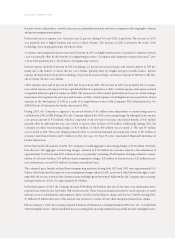American Express 2003 Annual Report Download - page 36
Download and view the complete annual report
Please find page 36 of the 2003 American Express annual report below. You can navigate through the pages in the report by either clicking on the pages listed below, or by using the keyword search tool below to find specific information within the annual report.
In addition, the cumulative balance sheet liability for unredeemed points is adjusted over time based on actual redemption
and cost experience with respect to redemptions. As of December 31, 2003, if the expected redemption rate for unredeemed
points was 100 basis points higher or lower, the reserve for Membership Rewards costs would change by approximately
$40 million.
In addition to the variables outlined above, the related provisions and reserves will be affected over time as a result of changes
in the number of cardmembers in the Membership Rewards program, the actual amount of points awarded and redeemed,
the actual weighted-average cost per point, the economic environment, the availability of Membership Rewards offerings
by vendors, the choices that cardmembers make in considering their rewards options, and possible changes that the Com-
pany could make to the Membership Rewards program in the future.
Investment securities valuation
Generally, investment securities are carried at fair value on the balance sheet with unrealized gains (losses) recorded in other
comprehensive income (loss) within equity, net of income tax provisions (benefits). At December 31, 2003, the Company
had net unrealized pretax gains on Available-for-Sale securities of $1.5 billion. Gains and losses are recognized in results of
operations upon disposition of the securities. In addition, losses are also recognized when management determines that a
decline in value is other-than-temporary, which requires judgment regarding the amount and timing of recovery. Indica-
tors of other-than-temporary impairment for debt securities include issuer downgrade, default or bankruptcy. The Com-
pany also considers the extent to which cost exceeds fair value, the duration and size of that gap, and management’s
judgment about the issuer’s current and prospective financial condition. Fair value is generally based on quoted market
prices. As of December 31, 2003, there were $211 million in gross unrealized losses that related to $11.7 billion of securities
(excluding structured investments), of which only $14 million has been in a continuous unrealized loss position for 12
months or more. The Company does not believe that the unrealized loss on any individual security at December 31, 2003
represents an other-than-temporary impairment, and the Company has the ability and intent to hold these securities for a
time sufficient to recover its amortized cost.
The Company’s investment portfolio also contains structured investments of various asset quality, including collateralized
debt obligations (CDOs) and secured loan trusts (backed by high-yield bonds and bank loans), which are not readily mar-
ketable. As a result, the carrying values of these structured investments are based on future cash flow projections that require
a significant degree of management judgment as to the amount and timing of cash payments, defaults and recovery rates of
the underlying investments and, as such, are subject to change. The carrying value will vary if the actual cash flows differ
from projected due to actual defaults or an increase in the near-term default rate. As an example, an increase in the near-
term default rate by 100 basis points, in and of itself, would reduce the cash flow projections by approximately $15 million
based on underlying investments as of December 31, 2003.
Deferred acquisition costs
Deferred acquisition costs represent the costs of acquiring new business, principally direct sales commissions and other dis-
tribution and underwriting costs that have been deferred on the sale of annuity, life and health insurance and, to a lesser
extent, property/casualty and certain mutual fund products. For annuity and insurance products, DAC are amortized over
periods approximating the lives of the business, generally as a percentage of premiums or estimated gross profits or as a
portion of the interest margins associated with the products. For certain mutual fund products, DAC are generally amor-
tized over fixed periods on a straight-line basis.
For annuity and life and health insurance products, the DAC balances at any reporting date are supported by projections
that show management expects there to be adequate premiums, estimated gross profits or interest margins after that date
to amortize the remaining balances. These projections are inherently uncertain because they require management to make
assumptions about financial markets and policyholder behavior over periods extending well into the future. Projection peri-
ods used for AEFA’s annuity business are typically 10 to 25 years, while projection periods for AEFA’s life and health insur-
ance products are often 50 years or longer. Management regularly monitors financial market conditions and compares actual
(p.34_axp_ financial review)
























